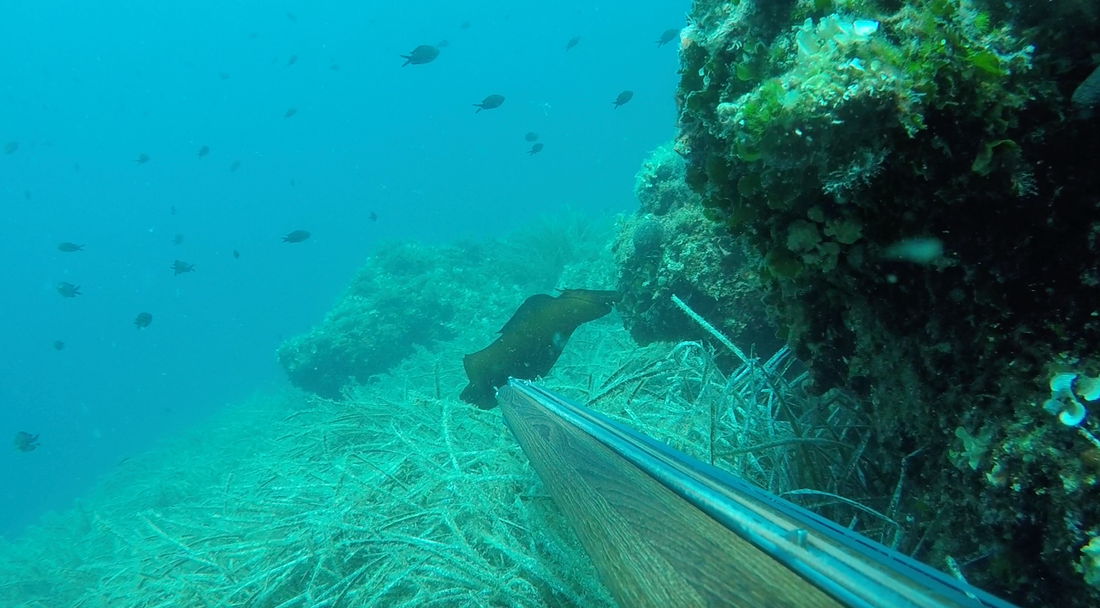
Meet the Marvel of the Adriatic: The Mysterious "Zekan" (Spotted Sea Hare)
Share
First time seeing it? You're not alone.
Just recently, while spearfishing along the rocky coastline of the Adriatic Sea, we encountered something magical: a soft, undulating marine creature slowly gliding through shallow waters, camouflaged among algae and rock. It was our first real-life sighting of the elusive zekan, also known as the spotted sea hare (Aplysia dactylomela), and it was nothing short of breathtaking.
In this detailed blog, we’ll dive deep into everything you need to know about this strange yet beautiful sea slug—from its biology and behavior to where you might encounter one and how to interact with it respectfully.
What is a Zekan?
In local Croatian and Slovenian terminology, "zekan" is a name used to describe large sea slugs, particularly species from the genus Aplysia. The most common species encountered in the Adriatic is the Aplysia dactylomela, or spotted sea hare.
Despite the name, sea hares are not actual hares (or rabbits); they are a type of marine gastropod mollusk. Their nickname comes from the two sensory appendages on their head (called rhinophores), which resemble rabbit ears.
Scientific Classification:
- Phylum: Mollusca
- Class: Gastropoda
- Order: Aplysiida
- Family: Aplysiidae
- Genus: Aplysia
- Species: Aplysia dactylomela
Physical Appearance
The spotted sea hare is one of the largest and most distinguishable sea slugs in the Adriatic Sea. It can grow up to 40 cm in length and weigh over 2 kg under optimal conditions.
Features to Notice:
- Color: Usually olive green or brown with distinctive black rings on the body
- Texture: Soft, gelatinous, with a mantle covering part of the body
- Parapodia: Flap-like structures used for swimming and protecting the body
- Rhinophores: The two ear-like structures used for detecting chemicals in the water
Habitat & Distribution
Sea hares are found in warm and temperate seas around the world. Aplysia dactylomela is widely distributed in the Mediterranean Sea, Adriatic Sea, Caribbean, and parts of the Pacific Ocean.
Preferred Habitat:
- Shallow coastal waters
- Seagrass meadows
- Algae-covered rocks
- Depths from 1–5 meters
They prefer areas with dense macroalgae, which provides both food and camouflage.
Behavior & Feeding Habits
Zekan is a herbivorous grazer, feeding mostly on algae. It uses a structure called a radula—a ribbon-like tongue with tiny teeth—to scrape algae off rocks.
Cool Fact:
When threatened, sea hares can release a purple ink to deter predators. This is a common defense mechanism, similar to octopuses.
Reproduction & Life Cycle
Sea hares are simultaneous hermaphrodites, meaning they have both male and female reproductive organs. During the breeding season, they can form mating chains of several individuals.
Life Stages:
- Egg laying: Eggs are laid in long, jelly-like ribbons.
- Larvae: Hatch into planktonic larvae (veligers).
- Juveniles: Settle on algae beds and grow into adults.
They have relatively short lifespans—about one year.
Ecological Role
Zekans play a vital role in maintaining ecological balance:
- Control algal growth
- Serve as prey for fish and invertebrates
- Indicate healthy underwater ecosystems
They are sensitive to pollution and require clean water to thrive, making them good bioindicators.
Where to Spot a Zekan in the Adriatic
- Coastal waters around Istria, Dalmatian islands, and parts of Slovenian coast
- Look for them near shallow rocks, underwater caves, and algae fields
Zekans are most often seen during warmer months, especially in late summer, when the water temperature is higher and algae is abundant.
Tips for Ethical Observation
If you’re lucky enough to spot a zekan, here’s how to observe it safely:
- Do not touch: Their bodies are extremely delicate.
- Avoid flashing lights: Use low-intensity light when filming.
- Take notes: Date, depth, size, and behavior can be useful data.
- Share sightings: Help marine researchers by reporting encounters.
Is it Dangerous?
No. Sea hares are completely harmless to humans. They don’t bite, sting, or release toxins harmful to divers. The purple ink they emit is only a mild deterrent and non-toxic.
Quick FAQs
Is it legal to collect sea hares in Croatia or Slovenia?
No. Collection of these marine animals without a scientific permit is generally prohibited.
What should I do if I see one?
Enjoy it, take a photo, and leave it undisturbed.
Can I keep it in an aquarium?
Highly discouraged. They require very specific water conditions and usually die quickly in captivity.
Final Thoughts
Zekan, the spotted sea hare, is one of the Adriatic’s most mysterious and awe-inspiring creatures. It reminds us that the sea is still full of surprises—even for experienced spearfishers and divers. Observing such a creature in the wild is a rare and unforgettable experience. Let’s protect them by keeping our waters clean and respecting their habitat.
Have you seen a zekan in the wild? Tag us on Instagram [@spikesub] with your photos!
